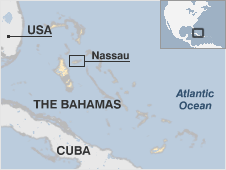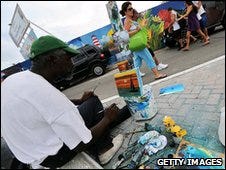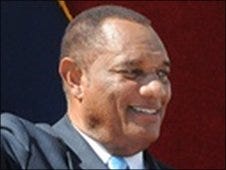Bahamas country profile
An archipelago of 700 islands and islets, the Bahamas attracts millions of tourists each year.
Map of Bahamas
An archipelago of 700 islands and islets, the Bahamas attracts millions of tourists each year.
The visitors come to enjoy its mild climate, fine beaches and beautiful forests.
A former British colony and now a Commonwealth member, the country is a major centre for offshore finance and has one of the world's largest open-registry shipping fleets.
OVERVIEW
Overview Facts Leaders Media
The Bahamas enjoys a high per capita income.
A street painter works on a painting to sell to tourists
Street painting in Nassau: the economy is based primarily on tourism
The huge growth in the services sector of the economy has prompted people to leave fishing and farming villages for the commercial centres in New Providence Island, Grand Bahama and Great Abaco.
This trend has compounded the islands' dependence on tourism and banking.
As with other Caribbean countries, The Bahamas faces the challenge of tackling drugs trafficking and illegal immigration. It has taken steps to clean-up its offshore banking system.
The Bahamas is a destination for migrants from its strife-torn Caribbean neighbour, Haiti. Tens of thousands of Haitians are thought to be living illegally in the country.
Bahamian culture is expressed most colourfully in "Junkanoo" street celebrations, which feature rhythmic music, dance and elaborate costumes and masks.
FACTS
Overview Facts Leaders Media
Full name: Commonwealth of the Bahamas
Population: 347,000 (UN, 2011)
Capital and largest city: Nassau
Area: 13,939 sq km (5,382 sq miles)
Major language: English
Major religion: Christianity
Life expectancy: 73 years (men), 79 years (women) (UN)
Monetary unit: 1 Bahamian dollar = 100 cents
Main exports: Pharmaceuticals, cement, rum, crawfish, refined petroleum products
GNI per capita: US$21,390 (World Bank, 2010)
Internet domain: .bs
International dialling code: +1242
LEADERS
Overview Facts Leaders Media
Head of state: Queen Elizabeth II, represented by a governor
Prime minister: Perry Christie
Prime Minister Perry Christie (Image: Bahamas Information Services)
Prime Minister Perry Christie (Image: Bahamas Information Services)
The Progressive Liberal Party returned to power at elections in May 2012, and party leader Perry Christie became prime minister for the second time. He defeated Hubert Ingraham's Free National Movement, which had won parliamentary elections in 2007.
The PLP had dominated Bahamian politics up until 1992, when the FNM swept to victory on an anti-corruption programme. The PLP returned to power in 2002, and the two parties have alernated in government ever since.
Mr Christie, 69, was prime minister in 2002-2007. Top of his agenda now is tackling the high unemployment rate, concerns about rising crime figures, and controversy over oil exploration.
Critics fear that oil development could harm the ecology and tourism sector. Mr Christie supports exploration, but insists he will protect the vital tourism industry.
MEDIA
Overview Facts Leaders Media
The government operates radio networks and the islands' only TV station. There is a handful of private radio stations. Multichannel cable TV is widely available.
The islands' privately-owned press carry a variety of views, including criticism of the government.
There were nearly 156,000 internet users by March 2011 (Internetworldstats.com).
The press
The Nassau Guardian - daily
The Tribune - daily
The Freeport News - daily
Television
ZNS TV - operated by government-owned, commercially-run Broadcasting Corporation of the Bahamas (BCB)
Radio
ZNS Bahamas - run by BCB, operates Radio Bahamas (ZNS1), Inspiration 107.9 (ZNS2), Northern Service (ZNS3), Power 104.5
Star FM - private, commercial
100 Jamz - private, commercial
Compiled by BBC Monitoring




